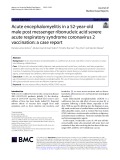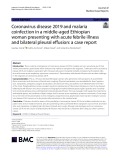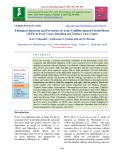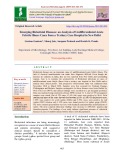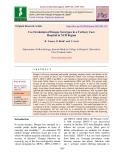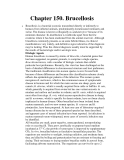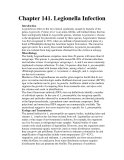
Acute febrile illness
-
Fusobacterium nucleatum is an anaerobic bacterium mainly responsible for acute or chronic infection of the ear, nose, and throat, potentially bacteremic with a risk of extraoral metastatic infection.
 6p
6p  vilazada
vilazada
 31-01-2024
31-01-2024
 4
4
 2
2
 Download
Download
-
Acute disseminated encephalomyelitis is a well-known, but rare, side effect of some vaccines, or symptom following a febrile illness. In this case, we highlight the need for a regulatory framework to assist clinicians and patients with coverage of treatment for acute disseminated encephalomyelitis.
 5p
5p  vitiki
vitiki
 30-01-2024
30-01-2024
 9
9
 2
2
 Download
Download
-
There could be misdiagnosis of coronavirus disease 2019 for malaria and vice versa because of their similar presentations, particularly when clinicians rely mainly on symptoms for diagnosis. Coinfection with coronavirus disease 2019 and malaria is associated with increased all-cause in-hospital mortality compared with isolated infection with severe acute respiratory syndrome coronavirus 2.
 5p
5p  vitiki
vitiki
 30-01-2024
30-01-2024
 10
10
 2
2
 Download
Download
-
China-Burma-India field party of the United States of America Typhus Commission has reported their observations on scrub typhus in Assam and Burma in 1946. Recently, sporadic cases have been reported from areas of Assam covered with scrub forests. Here we report few cases of scrub typhus presented with acute febrile illness associated with typical skin lesion of scrub typhus.
 5p
5p  nguathienthan8
nguathienthan8
 20-10-2020
20-10-2020
 7
7
 1
1
 Download
Download
-
Fever has become a common presenting complaint in the developing world. The symptoms and differential diagnosis of the most common fevers in the tropics that making an accurate clinical diagnosis was difficult without laboratory confirmation. These fevers also lead to high morbidity and mortality. But the exact burden of each infection varies from region to region. Due to high prevalence of local individual diseases the prioritization of the differential diagnosis of a clinical syndrome of acute undifferentiated febrile illness (AUFI) was needed.
 9p
9p  trinhthamhodang7
trinhthamhodang7
 31-08-2020
31-08-2020
 6
6
 1
1
 Download
Download
-
Scrub typhus (ST) is an acute febrile illness caused by Orientia tsutsugamushi, and is associated with considerable morbidity and mortality. ST has been considered as one of the most emerging infections in India as shown by the increase in the number of clinically diagnosed patients in various states except Uttar Pradesh. The present study was undertaken to look for ST amongst patients presenting with suggestive pyrexia of unknown origin (PUO) at a tertiary care centre in Uttar Pradesh.
 10p
10p  trinhthamhodang6
trinhthamhodang6
 09-07-2020
09-07-2020
 17
17
 1
1
 Download
Download
-
Objective of the study is to determine seroprevalence of dengue infection in patients suffering from AFI, seroprevalence of susceptible population and to ascertain whether it is appropriate time to introduce dengue vaccine CYD-TDV to susceptible population. A retrospective cross sectional observational study, of records of all patients of AFI, whose sera was subjected to simultaneous detection of dengue NS1 antigen, antidengue IgM and IgG antibody was done from July 2016 to July 2017 at a tertiary care center in eastern India
 7p
7p  chauchaungayxua5
chauchaungayxua5
 05-05-2020
05-05-2020
 6
6
 1
1
 Download
Download
-
Gloriosa superba (GSb) is a highly poisonous plant and its toxicity is due to anti-mitotic effects of constituents such as colchicine and gloriosine on rapidly proliferating cells. Poisoning is known to cause very rapid and severe clinical manifestations due gastro intestinal, neurological, cardiac and bone marrow toxicity.
 4p
4p  vienzym2711
vienzym2711
 30-03-2020
30-03-2020
 15
15
 1
1
 Download
Download
-
Glycosylation patterns of serum proteins, such as α1-acid glycoprotein, are modified during an acute phase reaction. The response of acute Kawasaki disease (KD) patients to IVIG treatment has been linked to sialic acid levels on native IgG, suggesting that protein glycosylation patterns vary during the immune response in acute KD.
 11p
11p  videshiki2711
videshiki2711
 21-02-2020
21-02-2020
 38
38
 1
1
 Download
Download
-
Health care providers lacking proper diagnostic tools are usually unable to determine specific etiologies, often diagnosing patients with acute undifferentiated febrile illness (AUFI) presumptively based on clinical features and assumptions regarding circulating pathogens. Acute fever can be potentially fatal if the etiology is not recognized and treated appropriately. A cross-sectional study was conducted in a tertiary care hospital, Bengaluru, from July-December 2018. Blood was collected from patients with acute fever for peripheral smear, serological tests.
 7p
7p  trinhthamhodang3
trinhthamhodang3
 12-02-2020
12-02-2020
 13
13
 0
0
 Download
Download
-
Rickettsial diseases are an important cause of undifferentiated acute febrile illness. The lack of classical manifestations can make their diagnosis difficult. Even though the diseases are endemic in India, they are less reported from New Delhi and surrounding regions. Aim is to estimate the seropositivity of Rickettsial infections in cases of undifferentiated acute febrile illness from a tertiary care hospital in New Delhi and to analyze their clinical profile. This prospective observational study was conducted from November 2016 to March 2018.
 9p
9p  kequaidan2
kequaidan2
 11-12-2019
11-12-2019
 23
23
 0
0
 Download
Download
-
Dengue is the most important and rapidly spreading mosquito-borne viral disease in the world. It is caused by any of the 4 serologically related virus serotypes designated as: DEN-1, DEN-2, DEN-3 and DEN-4, each causing its characteristic symptoms which range from acute febrile illness to severe manifestations (DHF and DHS). The present study focuses on the circulating serotypes of Dengue in this region. A total of 246 clinically suspected patients of Dengue fulfilling the WHO case definition were undertaken in the study.
 7p
7p  nguaconbaynhay1
nguaconbaynhay1
 04-12-2019
04-12-2019
 24
24
 0
0
 Download
Download
-
Brucellosis is a bacterial zoonosis transmitted directly or indirectly to humans from infected animals, predominantly domesticated ruminants and swine. The disease is known colloquially as undulant fever because of its remittent character. Its distribution is worldwide apart from the few countries where it has been eradicated from the animal reservoir. Although brucellosis commonly presents as an acute febrile illness, its clinical manifestations vary widely, and definitive signs indicative of the diagnosis may be lacking.
 12p
12p  crazy_sms
crazy_sms
 08-05-2012
08-05-2012
 61
61
 6
6
 Download
Download
-
Legionellosis refers to the two clinical syndromes caused by bacteria of the genus Legionella. Pontiac fever is an acute, febrile, self-limited illness that has been serologically linked to Legionella species, whereas Legionnaires' disease is the designation for pneumonia caused by these species. Legionnaires' disease was first recognized in 1976, when an outbreak of pneumonia took place at a hotel in Philadelphia during the American Legion Convention.
 13p
13p  crazy_sms
crazy_sms
 08-05-2012
08-05-2012
 64
64
 3
3
 Download
Download
-
The physician treating the acutely ill febrile patient must be able to recognize infections that require emergent attention. If such infections are not adequately evaluated and treated at initial presentation, the opportunity to alter an adverse outcome may be lost. In this chapter, the clinical presentations of and approach to patients with relatively common infectious disease emergencies are discussed. These infectious processes and their treatments are discussed in detail in other chapters. ...
 19p
19p  ozon_ozon
ozon_ozon
 26-04-2012
26-04-2012
 61
61
 2
2
 Download
Download
-
Tuyển tập báo cáo các nghiên cứu khoa học quốc tế ngành hóa học dành cho các bạn yêu hóa học tham khảo đề tài: A protocol for the emergency department management of acute undifferentiated febrile illness in India
 4p
4p  dauphong12
dauphong12
 07-02-2012
07-02-2012
 56
56
 2
2
 Download
Download
-
Sepsis with Skin Manifestations (See also Chap. 18) Maculopapular rashes may reflect early meningococcal or rickettsial disease but are usually associated with nonemergent infections. Exanthems are usually viral. Primary HIV infection commonly presents with a rash that is typically maculopapular and involves the upper part of the body but can spread to the palms and soles. The patient is usually febrile and can have lymphadenopathy, severe headache, dysphagia, diarrhea, myalgias, and arthralgias.
 5p
5p  thanhongan
thanhongan
 07-12-2010
07-12-2010
 82
82
 2
2
 Download
Download
-
Purpura Fulminans (See also Chaps. 136 and 265) Purpura fulminans is the cutaneous manifestation of DIC and presents as large ecchymotic areas and hemorrhagic bullae. Progression of petechiae to purpura, ecchymoses, and gangrene is associated with congestive heart failure, septic shock, acute renal failure, acidosis, hypoxia, hypotension, and death. Purpura fulminans has been associated primarily with N. meningitidis but, in splenectomized patients, may be associated with S. pneumoniae and H. influenzae.
 5p
5p  thanhongan
thanhongan
 07-12-2010
07-12-2010
 86
86
 2
2
 Download
Download
-
Necrotizing Fasciitis This infection may arise at a site of minimal trauma or postoperative incision and may also be associated with recent varicella, childbirth, or muscle strain. The most common causes of necrotizing fasciitis are group A streptococci alone (Chap. 130) and a mixed facultative and anaerobic flora (Chap. 119). Diabetes mellitus, peripheral vascular disease, and intravenous drug use are associated risk factors.
 5p
5p  thanhongan
thanhongan
 07-12-2010
07-12-2010
 78
78
 2
2
 Download
Download
-
Brain Abscess (See also Chap. 376) Brain abscess often occurs without systemic signs. Almost half of patients are afebrile, and presentations are more consistent with a space-occupying lesion in the brain; 70% of patients have headache, 50% have focal neurologic signs, and 25% have papilledema. Abscesses can present as single or multiple lesions resulting from contiguous foci or hematogenous infection, such as endocarditis. The infection progresses over several days from cerebritis to an abscess with a mature capsule.
 5p
5p  thanhongan
thanhongan
 07-12-2010
07-12-2010
 71
71
 2
2
 Download
Download
CHỦ ĐỀ BẠN MUỐN TÌM









